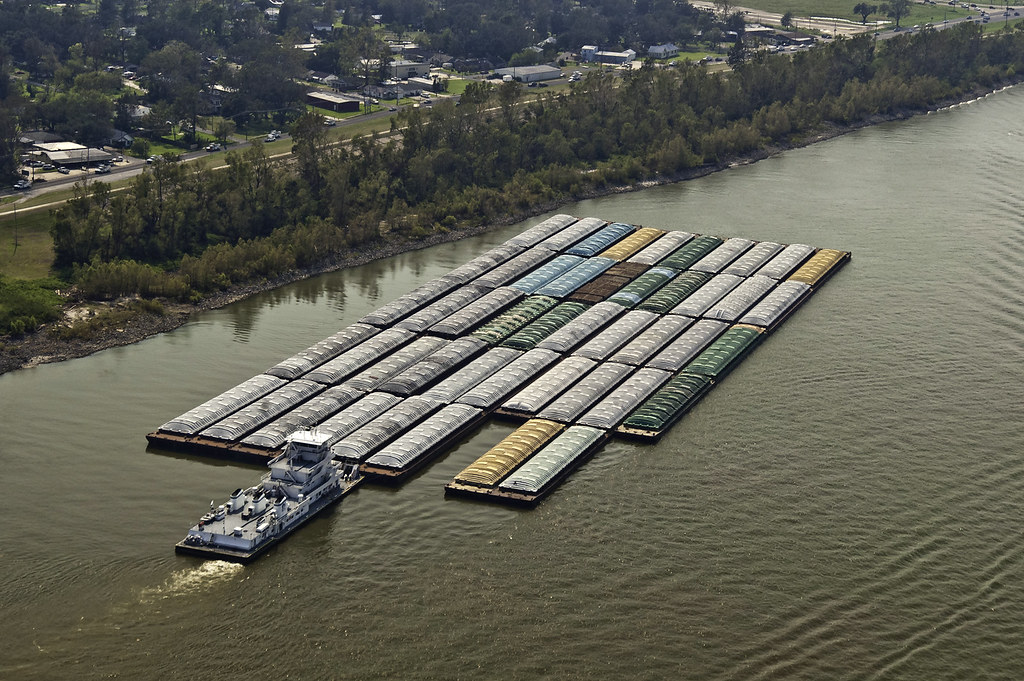Salt water is moving upstream under the Mississippi River. The solutions are all expensive, exacerbate the cause of the problem, or both.
The climate crisis is driving a wedge between Louisiana residents and the water they need to stay healthy, prosperous, and in some cases, alive.
In recent weeks, saltwater began working its way up the Mississippi river delta and currently threatens municipal water supplies in towns and cities that depend upon the mighty river. Two consecutive low-water years, fueled by drought conditions and heat domes throughout the Midwest, mean that there’s no longer enough water flowing downstream to push back saltwater from a rising Gulf of Mexico. The heavier sea water rolls in below the outbound fresh water, forming a wedge that has now worked its way about 70 miles inland. It doesn’t help that the land is slowly sinking, either.
Estimates for how long the wedge will take to reach the New Orleans area vary, and measures are being taken to delay its arrival as long as possible. Towns and cities downstream, however, are already affected.
On September 20th, the salt water overwhelmed a five foot high underwater levee, called a sill, on the riverbed. However, the Army Corps of Engineers is building another, 25 feet taller, which is expected to be completed on October 12th. The taller sill won’t stop the salt water wedge either, but it will delay its inevitable arrival upstream. Unfortunately, since the new sill will top out at 30 feet below the river’s surface, large ships will be limited to one deeper navigable lane, significantly slowing shipping activity during the busy harvest season.
Higher than expected river flow in September also delayed the saltwater intrusion’s arrival in the New Orleans area by several weeks, postponing it until late November, according to estimates from the Army Corps of Engineers.
Once it does reach New Orleans, though, emergency measures will be taken to dilute the incoming water before it reaches residents. A temporary, multimillion dollar pipeline will likely be built to bring water from upstream. Water will also be brought by barge, and used to dilute salty water at the intake. While these solutions help with the immediate problem of accessing potable drinking water, they would, in the end, reduce the volume of flow which is so critical for pushing the saltwater back down to the sea.
New Orleans mayor LaToya Cantrell and officials from neighboring Jefferson Parish say that no matter how salty the water gets, the water system won’t be shut off. Unfortunately, if the salinity reaches 250 milligrams per liter, that means the city’s 50,000 or so lead pipes could become corroded by saltier water, leaching lead and causing problems similar to those of Flint, MI and many other cities around the country with aging infrastructure and insufficient means to replace everything at once, or perhaps at all.

Even without extra lead, drinking saltier water is unhealthy, especially for people with high blood pressure or kidney disease. Those who are pregnant or nursing should also consider limiting intake of salty water.
The salt water influx affects more than just water drinkers, though.
Louisiana farmers face significant challenges. Any citrus growers who haven’t left because of the hurricanes or insect infestations will have to deal with irrigation water that kills their seedlings. Saltwater intrusion coupled with drought also creates problems for the rice farmers who raise crawfish as a second crop in their rice fields, as they have to decide whether to irrigate fields with water that adds to the soil’s salinity, or let it dry out and kill the immature crawfish and the stubble crops the crawfish eat. Farmers who do manage to raise exportable crops then must contend with lower water levels hampering their exports. Not only is it more expensive to move grain by train or truck, those higher-carbon alternatives don’t really help with the deeper causes of the drought that’s causing the saltwater wedge to creep up the river in the first place.
Neither boiling nor typical water filters will remove the salt. Farmers, other water-dependent businesses and those who like to stay hydrated without getting sick(er) do have some other options, such as buying reverse-osmosis systems. They’re expensive, though, starting around $300 for a countertop model, or $1000 for whole house filtration that would allow for showering or bathing. These systems are likely out of reach for those with few resources, and aren’t they always the ones who suffer the most during emergencies, both natural and economic?
In the end, the only real solution for the saltwater wedge is more fresh water flowing downstream. That may have to wait several months, whether autumn rains or winter snow melt from the Mississippi River basin eventually arrive to save the day. Predictions vary, but the upper Midwest looks to be in for a warmer, drier winter than last year, which doesn’t bode well.
Perhaps the dry states out west, which have long wanted to divert water from the Mississippi, should start figuring out better ideas for making the most of their own water, as well.
Related: Colorado River States to Face Reckoning

Join the conversation!